Measure How People Feel about Your Video Content with this Emotional Intelligence Platform
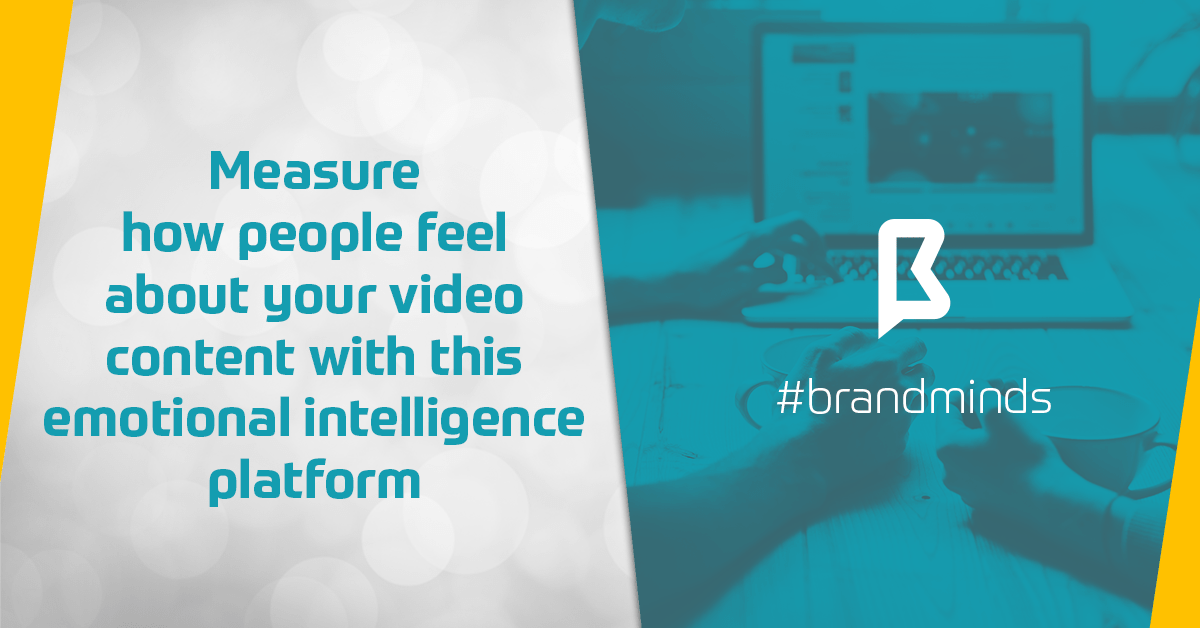
Latest statistics say that where both video and text are available on the same page, 72% of people would rather use video to learn about a product or service.
Learn more: Video Marketing Statistics 2018 – How Brands used Video for Business
Businesses acknowledged this rising trend in customer behaviour and began producing more video content to cater to their customers’ needs.
But when you produce video content (or any content for that matter!) you need to measure its impact on the consumer, you need to find out whether it had the expected outcome.
Realeyes is an emotional intelligence platform which uses the power of AI to help brands measure their video content at scale.
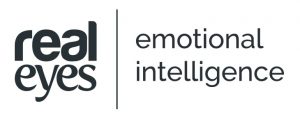
[bctt tweet=”Use Realeyes, the emotional intelligence platform to help you measure your video content at scale.” username=”brand_minds”]
With Realeyes marketers can:
- transform the impact of their video content;
- make more informed media decisions;
- eliminate media waste.
What is Realeyes?
Realeyes is an AI powered platform which uses computer vision and machine learning to measure how people feel as they view your video content online through their webcam.
It was co-founded by Mihkel Jäätma in 2007 at Oxford University. After ten years of breakthrough R&D innovation, Realeyes is now the technology leader in emotion AI for marketing performance, providing unfiltered emotional responses from consumers to businesses.
The innovative emotional intelligence platform has offices in Boston, London, New York and Budapest.
According to TechCrunch, the London-based startup has raised $16.2 million in funding, money that it plans to use to expand in engineering and business development.
It’s fast growing – revenues have shot up 932% in the last four years.
Some of its customers are Coca Cola, Mars, Publicis, Turner, Heineken, LG, Twix etc
How does Realeyes work?
Realeyes delivers results by running your video content through 4 stages:
1.Set the brief
Upload your own or competitor images, GIFs or videos at any stage of its life-cycle. Generally, we source a sample audience of 300 viewers based on your campaign objectives.
2. Collect Data
The platform measures the attention, emotions and sentiment of your sample audience as they watch your video content on their own device at home. You can even ask brand lift survey questions too.
3. Get results
The results are delivered to the Realeyes dashboard within 24 hours (depending on the sample), enabling you to slice and dice your audience data to see how different segments responded.
4. Act on insight
The Realeyes highly-experienced marketing professionals team craft your reports; this way your results are turned into valuable insights you can act on with confidence.

martechtoday.com
What does Realeyes measure?
Realeyes measures attention, emotions and sentiment.
1. Attention
The attention metric shows at which point your audience attention rises and falls whilst viewing your content. Attention is measured on volume and quality.
2. Emotions
Emotions are tracked with the help of the Realeyes Facial Action Coding System (FACS) used by Paul Ekman to categorise human facial movements.
Facial expressions are broken down into the individual Action Units that make up a specific expression over time. The output of your collected audience emotions is aggregated and displayed within the dashboard as six basic emotion metrics and three proprietary metrics for measuring the emotional experience.
The six basic emotions are: happiness, surprise, confusion, sadness, disgust, scared.
In addition to these basic emotion metrics, Realeyes also tracks a variety of proprietary metrics or classifiers.
These classifiers have been derived through their own research and are:
Engagement – when a participant has an expressive reaction to a stimulus.
Valence – whether a reaction is positive or negative.
Negativity – the percentage of people showing an emotion classified as negative.
3. Sentiment
With the sentiment analysis you can discover how audiences feel about your brand and content, expressed in their own words. Sentiment Analysis uses AI to analyse open ended consumer comments to identify the prevailing emotional opinion within the text, determining whether the overall sentiment is positive, negative, or neutral.
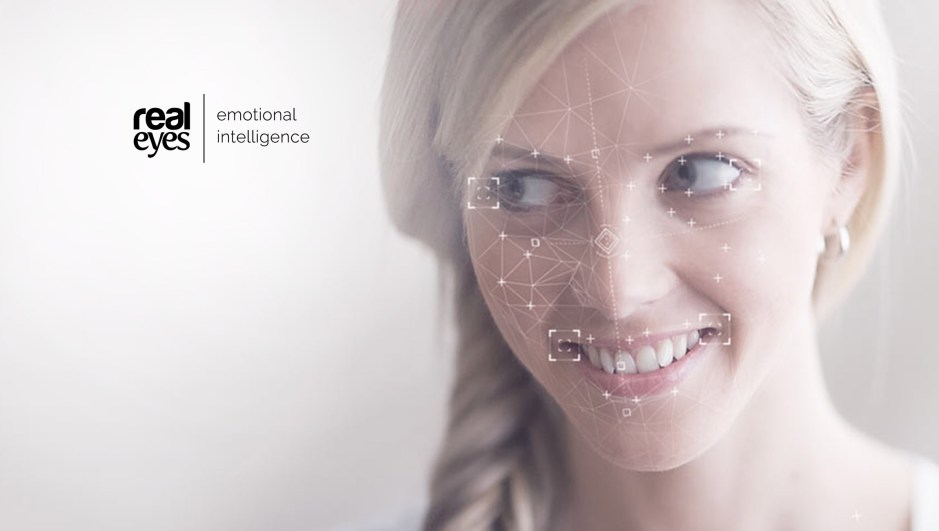
martechseries.com
Here are 6 benefits of using Realeyes:
1.Optimise video
With second by second emotion traces, see exactly how people react to your content – what works and where it might fall short.
2. Select winners
The Realeyes EmotionAll® score ranks your assets – see at a glance which videos to push or pull.
3. Target audiences
The score enables you to weed out the low performers and identify which demographic responds best to your video.
4. Compare norms
See how your video performs amongst different markets, genders, or age groups as well as custom demographic segments, in order to fully optimize your targeting.
5. Drive efficiency
Skew spend towards the most engaged audiences and invest in high performing content.
6. Predict performance
Capitalize on your earned media potential and inform channel split decisions based on the 1 to 10 score.
Additional advantages
- Snapshot result
Get an instant overview of what people are saying about your brand, ad or campaign with automatically ranked responses.
- Specific audience insight
By combining Sentiment Analysis data (consciously reported feedback) with our unique Attention and Emotion data (subconscious feedback), collected using webcams, we create a comprehensive report of the effectiveness of your creative.
- Global solution
Sentiment analysis is not restricted to English-speaking audiences, with analysis of French, German, Italian, Japanese, Korean, Portuguese, Spanish, Chinese (Simplified), Chinese (Traditional) also included.
- Automation
Unlike other similar tools that require manual effort, Sentiment Analysis is completely automated and is fully integrated into our dashboard.
Ideas for Strategic Thinking in Marketing
Strategic Analysis
It’s the process of developing strategy for a business by researching the business and the environment in which it operates. A strategic analysis will be referred to as a SWOT analysis: Strengths, Weaknesses, Opportunities, and Threats. Within these four areas, you will define your organization’s position relative to the competition and operational environments. While many believe it is best used at the organizational level, when properly implemented, a SWOT analysis will often return targeted, productive results at division or departmental levels of business. More about this step you can read here.
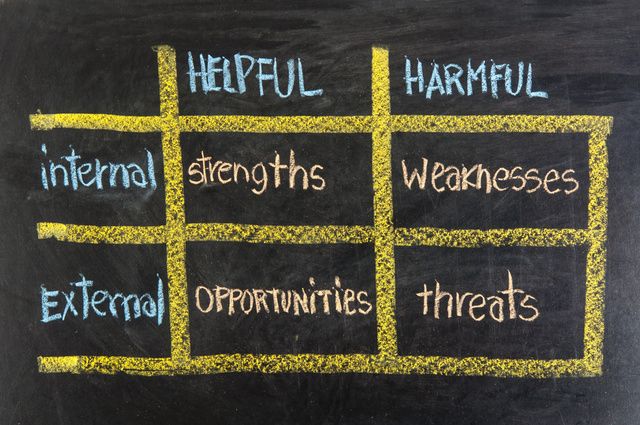
Scenario planning
The scenario planning technique constitutes a useful and practical way to think about the enterprise as a whole and its interaction with the environment. It refers to the formulation of alternative possible futures for the firm and its environment as a means of exploring the utility of different strategies. The scenario represented a landmark shift in management perspective, from a deterministic view (‘‘we can control our destiny’’) to the view that the future is intrinsically unpredictable (‘‘we need to envision a range of different
possible futures and prepare for them’’). Its pioneering implementation is usually attributed to Herman Kahn’s cold war studies at the RAND Corporation and the Hudson Institute and to Pierre Wack, who was head planner of the Royal Dutch Shell business environment division in the early 1970s.
other variables that reflect the overall progress of the firm towards its long-term objectives.
What’s most important is achieving high performance while balancing the needs of all the stakeholders.
The digital out-of-home advertising is already blooming
The share of global advertising spend going to out-of-home (OOH) advertising remains stable at 6 percent, shows ‘Why Out Of Home Performs’, a joint study by Magna Intelligence and Rapport, IPG Mediabrand’s out-of-home agency, into OOH’s continued growth and impact. The report was based on findings from an analysis of the global OOH industry and OOH advertising in 70 countries. This is largely down to major investment in digital OOH (or DOOH), which is growing in every environment and has seen unit numbers jump 70,000 to 300,000 worldwide in two years, and revenue increase by 30 percent.
Digital OOH is boosting advertising revenues by creating more opportunities for marketers in premium locations like airports or malls, thus increasing the revenue per panel multiple times. Although digital units account for only 5% of the global OOH inventory, they already generate 14% of total advertising revenues. In fact, DOOH already accounts for 30% of revenues in some markets like the UK and Australia, and the global share is predicted to grow to 24% globally by 2021.
“With the explosive growth of digital-out-of-home (DOOH), the diversified lifestyle touch points it reaches, and the veritable mountain of mobile driven audience data, we are best positioned to accurately, and in real-time, track audiences and deliver contextually relevant messages through out-of-home media. OOH’s sustained growth on a global scale will further enable us to create engaging consumer experiences,” said Mike Cooper, Global CEO Rapport.
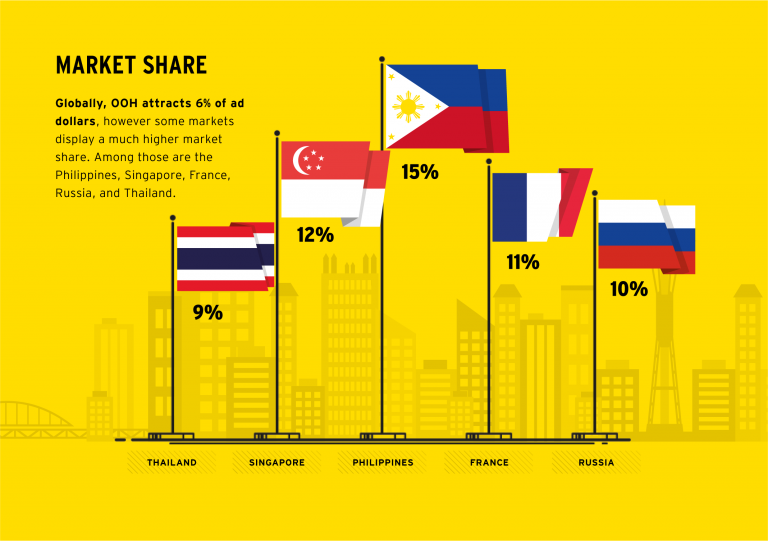
source: Campaign Asia
“The digital-out-of-home market is a return to advertising’s roots, quietly shifting the industry by way of re-imagining the classic advertising experience. Nearly $4.5 billion is expected to be spent on DOOH advertising in the U.S. by 2019, an increase of approximately $1.2 billion from 2016. Zenith forecasts that DOOH will grow faster globally than all other buying methods, and PricewaterhouseCoopers predicts that DOOH advertising revenues will overtake traditional media spend in 2020, growing at a rate of 15% a year for the next four years,” writes AdAge.com.
According to MAGNA, OOH advertising is now a $29 billion market, responsible for approximately 6% of the $500 billion global advertising spending. However, OOH market share increases to 10% to 12% in some countries, including France and Russia, compared with other media categories including Internet, TV, print and radio. OOH market share has remained stable in the last five years, hovering around 6%. However, as part of its increasing importance in the media mix, OOH market share has increased from 8% to 10% of traditional media advertising spend, which includes TV, print, radio and out-of-home, among other categories.
MAGNA Intelligence, in partnership with Rapport, conducted an in-depth survey in 22 key markets including Argentina, Australia, Belgium, Canada, China, Denmark, France, Germany, India, Italy, Japan, Malaysia, Mexico, Netherlands, Norway, Philippines, Russia, Singapore, Spain, Thailand, United Kingdom and the United States. The objective of the survey was to assess OOH advertising’s sustained growth and impact during a period where offline marketing budgets are stagnating and other media categories are struggling.
Moreover, MAGNA showed in another study launched in June, that in the USA, Out-of-Home (OOH) advertising is expected to grow +2% to $7.9 billion in 2017, including cinema. MAGNA reduces its 2017 growth forecast following weak first quarter advertising sales, which grew by just +0.3% in a sudden slowdown, as seven of the last eight quarters had shown year-over-year growth of +3% or more. The 1Q17 stagnation occurred as a result of several key verticals reducing spend, including both automotive and food & beverage, which both experienced double-digit declines. This offset the continued growth from tech brands (e.g. Google, Apple, Hulu and Netflix) that have driven OOH sales over the last two years.
The DOOH market encapsulates everything from digital billboards to screens in elevators to screens on jukeboxes. Unlike internet or mobile advertising, it allows advertisers to reach target audiences in a specific, real-world context. Instead of interrupting an internet user’s online experience with an ad, it’s focused on marketing to consumers when they are “on the go” in public places or in transit. Due to its specifications, the technology has the opportunity to give to its target the message in a format that’s automated, dynamic and interactive.
“The DOOH space presents a major opportunity for creatives, technologists and consumers alike. We see DOOH’s effectiveness in the numbers: the 2016 Nielsen OOH ad study found 91% of U.S. residents age 16 or older, who have traveled in a vehicle in the past month, noticed some form of OOH, and 79% noticed OOH in the past week. The same Nielsen digital billboards study found 71% of digital billboard viewers find those ads to stand out more than online ads. Ultimately, the emerging digital-out-of-home market is groundbreaking in its interactive technology, but it’s also a return to advertising’s roots and the original purpose around advertising: to provide an engaging and useful service to the public,” writes AdAge.
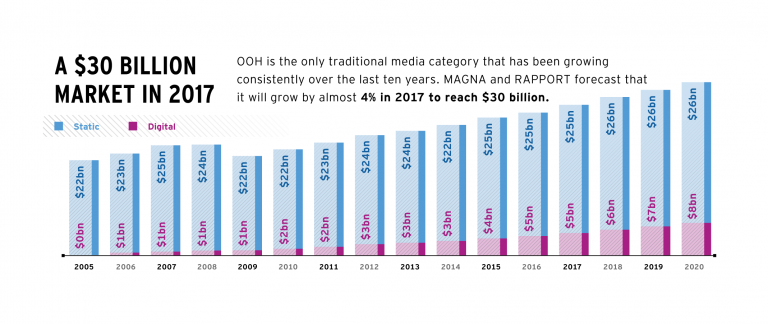
Globally, in 2016, the OOH market was worth $28 billion in net advertising, according to Magna’s report, and is predicted to grow by 4 percent per year to reach $33 billion by 2021. Behind this growth is an ever-more concentrated supply-side market, in which the top international OOH media owners are continuing to expand their influence: the six main global vendors (in order of 2016 revenue size, JCDecaux, Clear Channel, Outfront, Lamar, Stroer and Exterior) now control almost 40 percent of the whole market. By 2021, the report predicts small, but significant changes, in the environments most used for OOH. Use of billboards, currently the top revenue-generating segment and performing particularly well in India, Russia and the US, will drop 4 percent from 45 to 41 in the next five years. Street furniture and transit, meanwhile, are due to grow, respectively, from 31 to 34 percent and from 14 to 15 percent as local authorities become more willing to partner with OOH vendors. A series of major contracts—typically over 10 years long—in big cities are also in the process of renewal, the first time this has happened in the era of DOOH and programmatic opportunities, which partly explains DOOH’s recent giant revenue leap.
According to APAC, while the US is the largest OOH market, valued at $7.1 billion last year, APAC countries Japan ($4.7 billion) and China ($3.1 billion) come in at second and third position and per capita spending on OOH amounts to a record $38 per year in Japan, compared to $22 in the US. Singapore spends the second highest amount per capita at $36 a year. In the Philippines, meanwhile, OOH accounts for one of the highest percentage shares of overall ad spend in the world, at 15 percent compared to the global share of 6 percent. Singapore (12 percent) and Thailand (9 percent) also exceed the worldwide average.
Singapore’s OOH ads have the highest reach range of any other APAC market, with a penetration of 70 to 80 percent of the relevant population, due to its concentrated levels of urbanisation. Australia’s have the second highest, reaching 60 to 70 percent, but neither matches the reach of OOH ads in Argentina, which are considered seen by a huge 85 to 95 percent of the population.
In Australia, DOOH represents more than a third of total OOH spend, which the report attributes to a sophisticated advertising market and a population relatively concentrated in a few urban centers.
In China, the total OOH spend about matches other markets, it is one of the top five global markets in terms of penetration of digital, led by the transit segment. By 2021, MAGNA predicts that digital growth will have doubled, while OOH growth will be stagnating, partly due to lack of interest in non-digital inventory.
“OOH’s natural convergence with other digital media has hurt most other ad forms. OOH complements digital media by amplifying and enhancing it. This phenomenon has brought additional ad revenue to OOH, while most other media have experienced revenue losses as a result of the growth in digital.OOH has benefited from other new technologies, too, such as social media and mobile. Many OOH media campaigns are now picked up on social media, which greatly amplifies the total viewership. When consumers are on mobile devices, OOH is typically one of the last ad forms they’re exposed to just before important path-to-purchase decisions,” explained Steve Nicklin, Vice President of Marketing, OAAA, for billboardinsider.com.
The innovative opportunities provided by the digital platform have provided the OOH industry with new thinking and new ideas. Moreover, in the USA, as shown by the USA Touchpoints/RealityMine study, OOH and Today’s Mobile Consumer, consumers spend more time with OOH than any other form of advertising media except TV. The findings are supported by the 2016 Nielsen OOH ad study that found that 91% of US residents age 16 or older, who have traveled in a vehicle in the past month, noticed some form of OOH, and 79% have noticed OOH in the past week. Their research also discovered impressive levels of engagement, with 82% of billboard viewers reporting they look at the advertising message at least some of the time; and over one-third looking at the billboard ad each time or almost each time they noticed one. The Nielsen digital billboards study found 71% of digital billboard viewers find them to stand out more than online ads.
OOH is expanding to brand new environments. Digital screens have allowed OOH advertising vendors to penetration niche environment allowing to reach young urban population that is otherwise hard to reach by traditional media: offices, elevators, taxi, gyms, bars, retail etc. The “Digital Place-Based” segment offers targeting capabilities and programmatic opportunities. Moreover, OOH becomes addressable and experiments with programmatic. Initially developed to automate the trading of online display ads, the programmatic technologies are now being used in to buy and optimize ad campaigns on connected DOOH units.
Programmatic techniques not only optimize the workflow of media-buying but help brands deliver the right ad in the right place and at the right time, using consumer data and mobile location data. Giving advertisers the ability to plan, buy, optimize and measure the effectiveness of their outdoor campaigns through an online platform represents the natural evolution of OOH’s technology-driven transformation with many vendors developing Private Marketplaces (PMP).
Besides that, DOOH is going social. “There are two main avenues DOOH is being used to complement social campaigns, either through integration or through content creation,” says Neil Morris, founder and CEO of UK-based creative production house Grand Visual.










